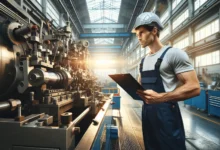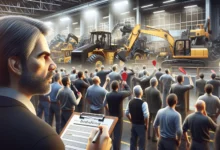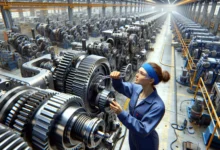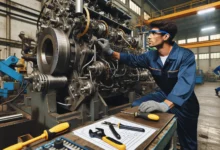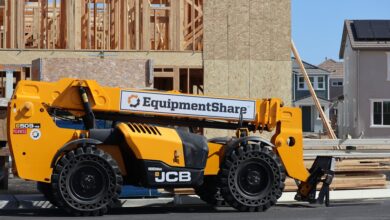Top Industrial Machinery Safety Tips: Protecting Workers, Preventing Accidents, and Ensuring Compliance
Advertisement
When I walk through a busy factory floor I can’t help but notice how powerful and complex industrial machines have become. These machines drive productivity and innovation but they also come with real risks if safety isn’t a top priority. One small mistake can lead to serious injuries or even halt operations completely.
I’ve learned that industrial machinery safety isn’t just about following rules—it’s about protecting lives and keeping businesses running smoothly. Whether you’re a machine operator a supervisor or just curious about workplace safety understanding the basics can make all the difference. Let’s explore why staying alert and informed matters more than ever in today’s fast-paced industrial world.
Understanding The Importance Of Industrial Machinery Safety
Recognizing the real risks of industrial machinery keeps everyone alert. Every year, industrial accidents result in serious injuries, financial losses, and production downtime according to OSHA data. Implementing strict safety standards helps protect lives and company assets at the same time.
Identifying potential hazards in machinery operations prevents injuries before they happen. Common risks include moving parts, electrical connections, and high-pressure systems. Training everyone who works with or around machines reduces these dangers sharply.
Enforcing regular inspections ensures that machinery stays compliant and safe. I always check for worn parts, malfunctioning sensors, and missing guards during routine maintenance. This proactive step helps avoid unexpected breakdowns and costly repairs.
Building a safety-first culture encourages employees to report unsafe conditions or practices. I support open communication and real-time feedback so every worker feels responsible for maintaining machinery safety.
Utilizing updated technology, such as automation, lockout/tagout devices, and safety interlocks, minimizes human error. I prefer solutions that integrate seamlessly with existing systems, letting processes flow without putting anyone at unnecessary risk.
Identifying Common Hazards In Industrial Machinery
Industrial environments present a range of hazards that can harm workers and disrupt operations. I always look for specific risks to prevent accidents and keep machinery running safely.
Mechanical Hazards And Moving Parts
Rotating shafts, gears, and conveyor belts pose the greatest mechanical hazards in factories. I see loose clothing or jewelry get caught in moving equipment, causing crush injuries or amputations. Unguarded blades and pinch points increase risks near cutting or pressing machines. I always make sure machines have well-maintained guards to protect my hands, arms, and clothing when working near moving components.
Electrical Risks And Faulty Wiring
Exposed wires, overloaded circuits, and damaged insulation create major electrical hazards. I’ve found that machinery with outdated or makeshift wiring can cause shocks, burns, or fires. Wet floors around electrical panels or connectors make the risk worse. I never skip checking for grounded connections and functional emergency switches before starting machinery, and I use lockout/tagout procedures every time I do repairs.
Thermal And Chemical Exposure
Hot surfaces, steam, and chemicals can burn skin or harm eyes in industrial settings. I stay alert for heating elements, molds, and welding arcs that create scalding temperatures. Spilled lubricants, cleaning solvents, acids, and fumes threaten my breathing and skin. I always wear PPE like gloves, goggles, and face shields when handling hazardous materials or working near heat sources to minimize direct exposure.
Implementing Safety Training For Employees
Safety training keeps employees alert and confident around industrial machinery. I focus on clear programs and regular drills to build strong safety habits and reduce accidents.
Developing Comprehensive Safety Programs
I design safety programs covering real-world risks, from moving parts to toxic chemicals. I include detailed modules explaining PPE usage, machine-specific hazards, emergency procedures, and reporting protocols. I customize the learning to job roles—so a machine operator, maintenance staff, and supervisor all get training that fits their daily tasks. I make sure new hires receive thorough onboarding safety sessions, and I keep materials updated to reflect new machinery or standards. I often use digital learning, visuals, and hands-on demonstrations to boost engagement and retention.
Conducting Regular Safety Drills
I schedule drills at least quarterly to simulate emergencies like machine malfunctions, electrical fires, or chemical spills. I set clear roles for each staff member, so they know exactly what to do—and I provide instant feedback afterward. I switch drill scenarios to cover all possible incidents, using tools like evacuation maps, alarm systems, and first-aid kits. I keep detailed records of participation and outcomes, making it easy to spot gaps in safety knowledge and address them in future training sessions.
Utilizing Personal Protective Equipment (PPE) Effectively
When working with industrial machinery, I make PPE a non-negotiable part of my safety routine. It protects me from injuries caused by moving parts, electrical hazards, and chemical exposure.
Selecting Appropriate PPE For Specific Machinery
I always select PPE based on the exact risks present with each machine. For example, when handling cutting or grinding equipment, I wear cut-resistant gloves, face shields, and safety goggles. When working around high-voltage panels, I opt for dielectric gloves and insulated footwear. In areas with corrosive chemicals, I go for chemical-resistant gloves, full-face respirators, and protective suits. Matching PPE to specific machinery is essential because what protects me from sparks won’t shield me from acid splashes or electrical shock.
Ensuring Proper Use And Maintenance Of PPE
I make sure to use my PPE correctly every time. That means wearing hard hats snugly with chin straps fastened, sealing goggles firmly against my face, and checking that earmuffs cover my ears fully to block out machine noise. I inspect my PPE before each use for cracks or tears, clean it regularly according to manufacturer instructions, and store it in a dry, accessible location. If I notice damage like frayed gloves or scratched visors, I replace them immediately. Consistently maintaining PPE helps me avoid hidden risks and ensures the highest level of protection on the job.
Maintaining And Inspecting Industrial Machinery Regularly
I make regular inspections and maintenance a key part of my industrial safety strategy. Consistent attention to machinery keeps equipment reliable and dramatically lowers the risk of accidents and costly breakdowns.
Scheduling Routine Inspections And Maintenance
I always set specific intervals for routine inspections and preventive maintenance based on manufacturer recommendations. For example, I create weekly, monthly, and annual checklists tailored to each machine—like oiling bearings on conveyor systems, testing emergency stops on press machines, and checking fluids in forklifts. I never skip these inspections because catching worn parts or leaks early helps me avoid unexpected failures and ensures compliance with OSHA and ISO safety standards.
Keeping Accurate Maintenance Records
I meticulously log every inspection and repair in digital or physical maintenance records. Each entry contains the date, tasks performed, parts replaced, and the technician’s name. Accurate records help me track wear patterns—like frequent belt changes or heating issues in hydraulic presses—and predict future maintenance needs. When audits come up or accidents are investigated, these detailed logs provide proof that I take machinery safety seriously and follow proper protocols.
Installing And Using Safety Devices On Machinery
I know that safety devices are critical on any industrial machine. It’s not just about compliance—it’s about ensuring everyone goes home safe at the end of the day.
Emergency Stop Buttons And Safety Guards
I always install emergency stop (E-stop) buttons on all major machines. These bright red buttons shut down equipment instantly in dangerous situations. For example, on conveyor belts and presses, E-stops can prevent injuries within seconds by triggering a full system halt.
I fit safety guards to cover moving parts like gears, fans, and blades. These barriers keep hands, clothing, and tools away from pinch points. I make sure the guards are interlocked, so machines won’t start unless they’re in place. According to OSHA, machines with proper guarding cut workplace injuries by over 30%.
Lockout/Tagout Procedures For Hazard Control
I rely on lockout/tagout (LOTO) to keep everyone safe during maintenance. LOTO involves disconnecting machines from energy sources and locking switches or valves, making accidental restarts impossible. I attach clearly labeled tags with my contact information. Whenever I service electrical panels, pumps, or mixing tanks, I follow a strict LOTO checklist so no one’s ever put at risk. OSHA estimates LOTO prevents over 120 fatalities and 50,000 injuries each year in the US.
| Safety Device/Procedure | Purpose | Example Machines | Key Benefit |
|---|---|---|---|
| Emergency Stop Button | Instant power cutoff | Presses, conveyors | Rapid response to danger |
| Safety Guards | Physical barrier over moving parts | Saws, gears, fans | Prevents contact injuries |
| Lockout/Tagout | Energy isolation before servicing | Electrical panels, pumps | Stops accidental energization |
I keep these devices and procedures at the core of my safety program, minimizing both human error and mechanical hazards.
Promoting A Culture Of Safety In The Workplace
Building a true safety culture takes more than just rules—it’s about shared attitudes and actions. I know that fostering a proactive environment where everyone values safety leads to fewer accidents, better morale, and long-term business success.
Encouraging Employee Reporting Of Unsafe Conditions
Empowering team members to speak up is one of the most powerful ways I drive continuous improvement in industrial machinery safety. Open communication means I’m always looking for input on unsafe conditions—whether it’s a loose machine guard, slippery floors, or a malfunctioning E-stop button. I make reporting procedures clear and simple, using anonymous hotlines or digital forms so no one fears retaliation. When employees know their voices matter, they spot issues before incidents occur and share real-time feedback that helps me prioritize corrective action.
Rewarding Safe Behavior And Compliance
Recognizing employees for safe choices shows that I value their commitment to safety standards. I set up regular safety awards, like small bonuses or public acknowledgments, for consistent PPE use, following lockout/tagout protocols, or suggesting practical improvements. I tie compliance metrics to quarterly performance reviews and team celebrations. By shining a spotlight on positive actions, I create a workplace where everyone wants to participate in maintaining and advancing our industrial machinery safety standards.
Conclusion
Staying proactive about industrial machinery safety isn’t just good practice—it’s essential for every workplace. When I prioritize safety at every level, I help protect people, equipment, and business operations from unnecessary risks.
I’ve seen firsthand that investing in training, proper equipment, and a culture of accountability pays off. By staying vigilant and committed to safety, I can make sure everyone goes home safe at the end of the day.
Frequently Asked Questions
What is the importance of safety in industrial machinery?
Safety in industrial machinery is crucial to protect workers’ lives, prevent injuries, and ensure smooth operations. Following proper safety practices reduces the risk of accidents, minimizes downtime, and helps companies avoid costly financial losses.
What are the most common hazards associated with industrial machinery?
Common hazards include mechanical risks from moving parts, electrical dangers from exposed or faulty wiring, and exposure to thermal or chemical elements. Each hazard can cause serious injuries if proper safeguards are not implemented.
Why is regular maintenance important for industrial machinery safety?
Regular maintenance ensures machines operate safely and efficiently. It helps identify worn components or leaks early, prevents unexpected breakdowns, and keeps equipment in compliance with safety regulations, reducing the risk of accidents.
What role does Personal Protective Equipment (PPE) play in machinery safety?
PPE, such as gloves, helmets, and safety glasses, protects workers from injuries related to moving parts, electrical hazards, and chemical exposure. Choosing the right PPE for specific tasks and maintaining it properly are essential for maximum protection.
How can companies build a culture of safety in industrial settings?
Companies can build a safety culture by promoting open communication, encouraging employees to report unsafe conditions, offering recognition for safe behavior, and providing ongoing training. This collective approach strengthens overall safety performance.
What are essential safety devices used on industrial machines?
Key safety devices include emergency stop (E-stop) buttons, safety guards to cover moving parts, and lockout/tagout (LOTO) systems to prevent accidental startups during maintenance. These devices help prevent both human error and mechanical hazards.
How should safety training be provided to industrial workers?
Safety training should be job-specific and include hands-on demonstrations, digital learning modules, and regular safety drills. Thorough onboarding for new employees and periodic refresher courses help foster strong safety habits and awareness.
Why is it important to keep maintenance and inspection records?
Keeping detailed maintenance and inspection records tracks machine wear, documents compliance with safety regulations, and provides proof during audits or accident investigations. This helps identify trends and improves safety management.
What should employees do if they notice unsafe conditions in the workplace?
Employees should promptly report unsafe conditions to their supervisor or safety officer. Open reporting helps resolve hazards quickly and improves overall workplace safety, especially when there is no fear of retaliation.
How does updated technology improve industrial machinery safety?
Modern technologies, such as automation and advanced safety devices, reduce human error, provide real-time monitoring, and enhance protection against hazards. Using updated technology helps ensure safer and more efficient industrial operations.
